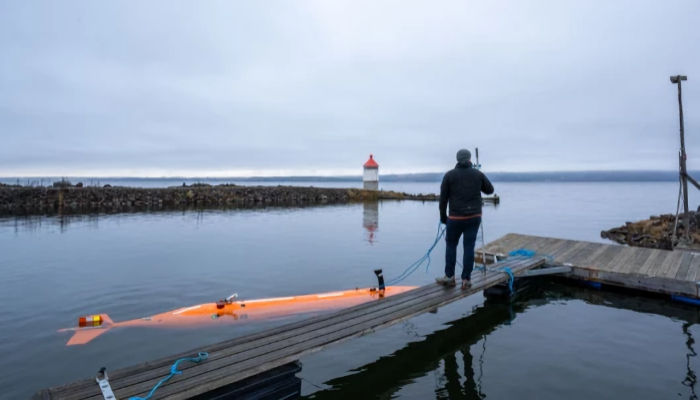Sonar Images Reveal The Existence Of A 700-Year-Old Shipwreck At The Bottom Of Lake Mjøsa, Norway
Jan Bartek – MessageToEagle.com – Scientists report sonar images reveal an intriguing shipwreck resting at the bottom of Lake Mjøsa in Norway. Though this is Norway’s largest lake marine archaeologists say the lake is more like a miní-ocean or large fjord than a lake.
Sonar images reveal the existence of a shipwreck, possibly from the Middle Ages, at the bottom of Norway’s largest lake, Mjøsa. (Photo: FFI/NTNU)
The shipwreck found by the autonomous underwater vehicle Hugin from the Norwegian Defence Research Establishment at 410 meters dates to sometime between 1300 – 1850. Scientists suggest it is perhaps 700-year-old. The underwater secrets of Lake Mjøsa are still awaiting investigations. Until now, the lake has never been examined beyond a scuba diving depth of around 20-30 meters.
“We believed that the chance of finding a shipwreck was quite high, and sure enough, a ship turned up,” says marine archaeologist Øyvind Ødegård from NTNU.
The ship is about ten metres long – it’s possible that it originally was a bit longer – and 2,5 metres wide. This places it somewhere in between the categories of a large boat or a ship, according to Ødegård.
At one end, it looks as though the strakes are no longer fastened properly to the ship, which indicates that the iron nails fastening them have probably begun to rust and disintegrate.
“This tells us that the ship has probably been at the bottom of Mjøsa for a while,” Ødegård says.
The Norwegian newspaper VG excitedly announced for a brief time that the archaeologists had discovered a Viking ship, but this is not the case.
The autonomous underwater vehicle Hugin on its way to map the bottom of lake Mjøsa. (Photo: Merete Nyheim/NTNU)
Ødegård explains that Viking ships usually have the steering oar on the side of the ship. During the Middle Ages, the steering oar was rather placed right at the back of the ship – and judging by the images obtained, this is what the shipwreck in question has,” Science in Norway reports.
“If this is correct, it is highly likely that the ship is not older than from the 1300s,” Ødegård says.
The ship is clinker built, a Nordic tradition of ship building also known from the Viking ships and listed on the UNESCO list of Intangible Cultural Heritage.
“If we found a medieval ship, we would really be hitting the bullseye, it would be fantastic, but we don’t dare to hope yet,” Ødegård said in an article about exploring Mjøsa two years ago. Now it seems they may have found just that. (Photo: FFI/NTNU)
“This tradition is recognized as a very important part of our cultural heritage,” says Ødegård.
Ødegård added Lake Mjøsa is a “more or less unknown territory,” which is the reason why NTNU will start a five-year-old project focusing on the exploration of Lake Mjøsa. Vice principle for NTNU, in Gjøvik, Gro Dæhlin, says to the newspaper VG that Mjøsa is a treasure trove for old ships.
As reported by Science in Norway, “Director of Mjøsmuseet, Arne Julsrud Berg, is also very excited about the find.
He tells VG that there were huge naval battles on Mjøsa in the 1100s and 1200s, when large fleets including ships the size of the famous Gokstad Viking ship met in battle on the water.
“Even during the Viking Age there were huge sea battles on Mjøsa,” Berg says to VG.
See also: More Archaeology News
The areas surrounding Mjøsa were wealthy farm areas, and goods have been transported across Mjøsa to and from Oslo throughout the centuries.”
Raising the ship would probably pose a very complex task. Ødegård is uncertain whether this has ever been done with robots.
Written by Jan Bartek – MessageToEagle.com – AncientPages.com Staff Writer













